Systematic Review: The Ecology and Cultural Significance of Oysters in the Arabian Gulf
Abstract
1. Introduction
1.1. Background and Significance
- Characterize the species composition and spatial distribution of oyster beds across Gulf subregions, identifying habitat affinities and depth ranges.
- Evaluate ecological functions, including reef geomorphology, filtration performance, and associated biodiversity support.
- Assess environmental threats, focusing on contaminant bioaccumulation, habitat loss, climate stressors, and invasive species risk.
- Examine cultural dimensions, tracing the historical pearling industry’s rise and decline and current heritage preservation initiatives.
- Synthesize conservation actions and recommendations, highlighting the restoration outcomes, policy frameworks, and research priorities necessary to safeguard Gulf oyster reefs for future generations.
1.2. Rationale for the Systematic Review
1.3. Research Questions and Objectives
- What is the current state of knowledge regarding oyster species diversity, distribution, and taxonomy in the Arabian Gulf?
- What ecological functions and ecosystem services do oysters provide in the Arabian Gulf marine environment?
- What are the major threats and stressors affecting oyster populations in the region?
- What is the current conservation status of oyster habitats, and what management measures are in place?
- How has the cultural and economic significance of the oysters in the Arabian Gulf evolved over time, and what are the critical knowledge gaps and research priorities for oyster conservation in this region?
2. Methods
2.1. Systematic Review Protocol
2.2. Search Strategy
- Reference lists of the included studies were checked (backward citation tracking).
- Citations of key papers were searched for (forward citation tracking).
- Key journals in marine biology, ecology, and conservation were searched.
- Gray literature searches, including conference proceedings, technical reports, and theses, were performed.
- Regional experts were consulted to identify additional relevant sources.
2.3. Inclusion and Exclusion Criteria
2.4. Data Extraction and Quality Assessment
2.5. Narrative Synthesis and Quantitative Summaries
3. Ecological Significance
3.1. Oyster Species and Habitat Distribution
3.2. Reef Architecture and Biodiversity Facilitation
3.3. Filtration and Biogeochemical Influence
3.4. Contaminant Bioaccumulation and Indicator Role
4. Environmental Challenges and Threats
4.1. Climate Change
4.2. Pollution and Contaminants
4.3. Coastal Development and Habitat Loss
4.4. Fishery and Harvesting Pressure
5. Cultural Significance
5.1. Historical Pearl Industry
5.2. Heritage Preservation and Identity
5.3. Contemporary Revitalization
6. Conservation and Management
6.1. Restoration Trials
6.2. Knowledge Gaps and Research Needs
- Distribution and status: Comprehensive, Gulf-wide maps of the extent of live reefs are still lacking; the most detailed benthic surveys to date cover only the Northern Emirates of the UAE and a handful of historical pearling grounds in Qatar and Bahrain at a decadal scale [9]. For example, Bahrain’s environmental agencies have recently mapped its key pearl oyster banks (such as Hayr Shtayyah and Hayr Bu Amam) to establish baseline distributions [25]. Limited data exist outside these areas, and synoptic side-scan and drop-camera surveys (with a unified geodatabase) are needed to track oyster reef loss and recovery across the Gulf.
- Population dynamics: Key life history parameters—annual recruitment rates, growth trajectories, size-specific fecundity, and natural mortality—remain unquantified for the Gulf’s pearl oyster (Pinctada radiata) and rock oyster (Saccostrea cuccullata). Without long-term tagging or cohort-tracking studies, population bottlenecks cannot be identified, and biologically realistic restoration targets cannot be set. Long-term mark–recapture or size–frequency studies would fill these gaps.
- Climate thresholds: Gulf oysters survive extreme conditions (temperature > 36 °C, hypersalinity) that kill most Indo-Pacific oysters, but the upper tolerance limits are still unresolved. Recent experiments show that exposing P. radiata to elevated temperatures, high CO2 (low pH) levels, and pollutants downregulates the genes for shell formation [42], indicating stress under predicted future conditions. Controlled multi-stressor trials (simultaneous heat, salinity, acidification) are therefore essential to project reef persistence under climate change [42].
- Restoration engineering: Pilot program deployments in the Gulf have tested various substrates (e.g., crushed shell, limestone, 3D concrete modules) [14]. However, comparative data are scarce: systematic studies comparing substrate longevity, spat retention, and post-settlement growth across salinity or turbidity gradients are lacking. Standardized before–after monitoring of multiple substrates and seeding densities is needed to determine which designs perform best under the Gulf’s conditions.
- Socio-ecological integration: Effective reef restoration will require engaging the coastal communities whose heritage includes pearl diving. To date, no published study has systematically documented the traditional ecological knowledge of retired pearl divers or fishing communities in the Gulf. Incorporating this local knowledge into site selection, monitoring, and outreach could improve both the ecological outcomes and social legitimacy of restoration projects.
6.2.1. Methodological Limitations
- Sampling in extreme environments: Summer air temperatures above 45 °C, high turbidity, and strong tidal currents restrict dive time and bias field work toward easily accessed reefs, leaving remote shoals in Qatar, Saudi Arabia, and Iran under-sampled.
- Standardization across studies: Species-identification keys, quadrat sizes, and filtration rate assays vary widely between projects, hindering direct comparisons. A Gulf-wide monitoring handbook modeled based on the National Oceanic and Atmospheric Administration (NOAA) “Oyster Habitat Restoration Monitoring and Assessment Handbook” would greatly improve coherence.
- Analytical constraints: The limited local capacity for next-generation sequencing, trace-metal speciation, and histopathology means that many genomic and ecotoxicological questions still rely on samples exported to overseas labs, increasing costs and turnaround time.
- Data sharing and accessibility: Valuable reports are scattered in government gray literature or regional Arabic-language journals with low digital visibility, making systematic reviews laborious and risking the duplication of efforts.
6.2.2. Emerging Research Questions
- Climate trajectories: How will Gulf oyster populations respond to the IPCC SSP-5 temperature pathway, and what cascading effects will this have on reef filtration capacity, shoreline stability, and fishery productivity?
- Habitat baselines: What is the current distribution, extent, and structural condition of oyster beds across all eight Gulf countries, and how have these metrics shifted since the mid-1900s?
- Restoration efficacy: Which substrate types and seeding densities optimize survival and growth under hypersaline (≥42 psu) and hyperthermal (>34 °C) regimes, and how can successes be scaled from pilot program plots (<0.1 ha) to the landscape level (>10 ha)?
- Multiple-stressor interactions: How do warming, acidification, brine salinity, and metal loads interact additively or synergistically to influence oyster physiology, reef accretion rates, and larval connectivity?
- Knowledge integration: How can the oral histories and site-selection heuristics of former pearl divers be systematically captured and blended with remote sensing data to refine restoration siting?
6.3. Threat Mitigation
6.4. Integrated Management Framework
- Protected Area Designation: Existing Marine Protected Areas (MPAs) should be expanded to encompass critical oyster reef habitats, establishing core no-take zones and buffer areas. Enforcement must involve patrols, community rangers, and satellite vessel monitoring.
- Eco-engineered Infrastructure: Seawalls, breakwaters, and jetties should be retrofitted with textured surfaces and prefabricated modules that facilitate oyster settlement, creating ”living shorelines” that combine coastal defense with reef habitat.
- Community Engagement and Citizen Science: Oyster restoration networks that train volunteers and fishers in reef monitoring protocols, data entry via mobile applications, and early-warning reporting of disease or bleaching events should be formalized.
- Regional Coordination under the Regional Organization for the Protection of the Marine Environment (ROPME): A Gulf Oyster Restoration Network (GORN) should be established under the Regional Organization for the Protection of the Marine Environment. A GORN would standardize monitoring methodologies, coordinate cross-border funding proposals, and disseminate restoration toolkits and genetic stock information.
- Adaptive Governance: Iterative policy cycles should be implemented, where restoration outcomes and threat assessments inform regulatory adjustments. Transdisciplinary working groups comprising scientists, traditional pearl divers, policymakers, and private sector stakeholders should meet biannually to update action plans.
7. Conclusions
- Scale up science-based restoration: Early trials show promise, but the gulf between pilot project plots and the hundreds of square kilometers of historical reef footprints remains vast. A regional hatchery network, common genetic management guidelines, and unified performance metrics are prerequisites for cost-effective expansion [10].
- Shrink cumulative stressors: Even the best-designed reefs will fail if overlaid by chronic pollution and unchecked coastal infill. Harmonized discharge limits for heavy metals (<50 µg L−1 for Pb and Cd) and salinity offsets (<2 psu above ambient levels) at desalination outfalls, coupled with 100 m coastal-setback zones around extant reefs, are minimum safeguards [2,31].
- Institutionalizing regional cooperation: The proposed Gulf Oyster Restoration Network under ROPME could coordinate larval-connectivity studies, share spat-production technology, and channel international climate-adaptation finance toward reef projects that deliver both biodiversity gains and cultural revitalization [33].
Funding
Institutional Review Board Statement
Informed Consent Statement
Data Availability Statement
Acknowledgments
Conflicts of Interest
References
- Sale, P.F.; Feary, D.A.; Burt, J.A.; Bauman, A.G.; Cavalcante, G.H.; Drouillard, K.G.; Kjerfve, B.; Marquis, E.; Trick, C.G.; Usseglio, P.; et al. The Growing Need for Sustainable Ecological Management of Marine Communities of the Persian Gulf. Ambio 2011, 40, 4–17. [Google Scholar] [CrossRef]
- Sheppard, C.; Al-Husiani, M.; Al-Jamali, F.; Al-Yamani, F.; Baldwin, R.; Bishop, J.; Benzoni, F.; Dutrieux, E.; Dulvy, N.K.; Durvasula, S.R.V.; et al. The Gulf: A Young Sea in Decline. Mar. Pollut. Bull. 2010, 60, 13–38. [Google Scholar] [CrossRef]
- Joydas, T.V.; Manokaran, S.; Gopi, J.; Jayachandran, P.R.; Yu-Jia, L.; Heinle, M.; Nazal, M.K.; Manikandan, K.P.; Qashqari, M.; Mohandas, S.P.; et al. Advancing Ecological Assessment of the Arabian Gulf through EDNA Metabarcoding: Opportunities, Prospects, and Challenges. Front. Mar. Sci. 2024, 11, 1276956. [Google Scholar] [CrossRef]
- Paparella, F.; D’Agostino, D.; Burt, J. Long–Term, Basin–Scale Salinity Impacts from Desalination in the Arabian/Persian Gulf. Sci. Rep. 2022, 12, 20549. [Google Scholar] [CrossRef]
- Khalifa, R.; Hamadou, R.B.; Giraldes, B.W.; Joaquim, S.; Hizam, Z.; Hamza, S.; Bassères, A.; Massabuau, J.C.; Leitão, A. The Impact of Increasing Seawater Temperatures over the Last 30 Years on the Reproductive Cycle of the Pearl Oyster Pinctada radiata (Leach, 1814) in the Arabian Gulf. J. Mar. Sci. Eng. 2024, 12, 2180. [Google Scholar] [CrossRef]
- Fieseler, C.M.; Al-Mudaffar Fawzi, N.; Helmuth, B.; Leitão, A.; Al Ainsi, M.; Al Mukaimi, M.; Al-Saidi, M.; Al Senafi, F.; Bejarano, I.; Ben-Hamadou, R.; et al. Expanding Ocean Protection and Peace: A Window for Science Diplomacy in the Gulf. R. Soc. Open Sci. 2023, 10, 230392. [Google Scholar] [CrossRef] [PubMed]
- Burt, J.A.; Bartholomew, A.; Feary, D.A. Man-Made Structures as Artificial Reefs in the Gulf. In Coral Reefs of the Gulf; Springer: Berlin/Heidelberg, Germany, 2012; pp. 171–186. [Google Scholar]
- Feary, D.A.; Burt, J.A.; Bartholomew, A. Artificial Marine Habitats in the Arabian Gulf: Review of Current Use, Benefits and Management Implications. Ocean Coast. Manag. 2011, 54, 742–749. [Google Scholar] [CrossRef]
- Bejarano, I.; Mateos-Molina, D.; Knuteson, S.L.; Solovieva, N.; Yaghmour, F.; Samara, F. Oyster Beds and Reefs of the United Arab Emirates. In A Natural History of the Emirates; Springer: Berlin/Heidelberg, Germany, 2023; pp. 353–384. [Google Scholar]
- Giraldes, B.W.; Smyth, D.; Chatting, M.; Al-Ashwel, A.A.; Al-Omary, N.H.; Mello, L.G.S.; Engmann, A.; Leitão, A. Increasing Knowledge to Restore Oyster Beds and Related Services in the Arabian-Persian Gulf. Reg. Stud. Mar. Sci. 2023, 66, 103172. [Google Scholar] [CrossRef]
- Salvi, D.; Al-Kandari, M.; Oliver, P.G.; Berrilli, E.; Garzia, M. Cryptic Marine Diversity in the Northern Arabian Gulf: An Integrative Approach Uncovers a New Species of Oyster (Bivalvia: Ostreidae), Ostrea Oleomargarita. J. Zool. Syst. Evol. Res. 2022, 2022, 7058975. [Google Scholar] [CrossRef]
- Samimi-Namin, K.; Hoeksema, B.W. Hidden Depths: A Unique Biodiversity Oasis in the Persian Gulf in Need of Further Exploration and Conservation. Diversity 2023, 15, 779. [Google Scholar] [CrossRef]
- Samara, F.; Bejarano, I.; Mateos-Molina, D.; Abouleish, M.; Solovieva, N.; Yaghmour, F.; Ali, T.; Saburova, M. Environmental Assessment of Oyster Beds in the Northern Arabian Gulf Coast of the United Arab Emirates. Mar. Pollut. Bull. 2023, 195, 115442. [Google Scholar] [CrossRef] [PubMed]
- Howie, A.H.; Bishop, M.J. Contemporary Oyster Reef Restoration: Responding to a Changing World. Front. Ecol. Evol. 2021, 9, 689915. [Google Scholar] [CrossRef]
- Smyth, D.; Al-Maslamani, I.; Chatting, M.; Giraldes, B.W. Benthic Surveys of the Historic Pearl Oyster Beds of Qatar Reveal a Dramatic Ecological Change. Mar. Pollut. Bull. 2016, 113, 147–155. [Google Scholar] [CrossRef] [PubMed]
- Smyth, D.; Al-Maslamani, I.; Giraldes, B.W.; Chatting, M.; Al-Ansari, E.M.A.S.; Vay, L. Le Anthropogenic Related Variations in the Epibiotic Biodiversity and Age Structure of the “Pearl Oyster” Pinctada radiata within the Eulittoral Zone of Qatar. Reg. Stud. Mar. Sci. 2016, 5, 87–96. [Google Scholar] [CrossRef]
- Carter, R. The History and Prehistory of Pearling in the Persian Gulf. J. Econ. Social. Hist. Orient 2005, 48, 139–209. [Google Scholar] [CrossRef]
- Bento, R.; Jabado, R.W.; Sawaf, M.; Bejarano, I.; Samara, F.; Yaghmour, F.; Mateos-Molina, D. Oyster Beds in the United Arab Emirates: Important Fishing Grounds in Need of Protection. Mar. Pollut. Bull. 2022, 182, 113992. [Google Scholar] [CrossRef]
- Aqil, K. Pearl Industry in the UAE Region in 1869–1938: Its Construction, Reproduction, and Decline. Rudn. J. Sociol. 2018, 18, 452–469. [Google Scholar] [CrossRef]
- Helmer, L. Restoration of Oysters and Associated Habitats in the United Arab Emirates: Literature Review & Feasibility Study; Blue Marine Foundation (on behalf of DP World): London, UK, 2022; 88p. [Google Scholar]
- Hamza, W.; Munawar, M. Protecting and Managing the Arabian Gulf: Past, Present and Future. Aquat. Ecosyst. Health Manag. 2009, 12, 429–439. [Google Scholar] [CrossRef]
- Page, M.J.; McKenzie, J.E.; Bossuyt, P.M.; Boutron, I.; Hoffmann, T.C.; Mulrow, C.D.; Shamseer, L.; Tetzlaff, J.M.; Akl, E.A.; Brennan, S.E.; et al. The PRISMA 2020 Statement: An Updated Guideline for Reporting Systematic Reviews. BMJ 2021, 372, 71. [Google Scholar] [CrossRef]
- Critical Appraisal Skills Programme CASP (Systematic Review) Checklist. Available online: https://casp-uk.net/casp-tools-checklists/ (accessed on 17 June 2025).
- De Mora, S.; Fowler, S.W.; Wyse, E.; Azemard, S. Distribution of Heavy Metals in Marine Bivalves, Fish and Coastal Sediments in the Gulf and Gulf of Oman. Mar. Pollut. Bull. 2004, 49, 410–424. [Google Scholar] [CrossRef]
- Hazeem, L.J.; Yusuf, M.; Al-Sayed, H. Pearl Oysters in Bahrain. In Coral Reefs and Associated Marine Fauna around the Arabian Peninsula; Taylor Francis Group: Abingdon, UK, 2024; pp. 145–152. [Google Scholar]
- Walton, M.; Hayes, J.; Al-Ansi, M.; Abdallah, M.; Al Maslamani, I.; Al-Mohannadi, M.; Al-Shaikh, I.; Al-Shaikh, I.; Jackson, T.D.; Szostek, C.L.; et al. Towards Spatial Management of Fisheries in the Gulf: Benthic Diversity, Habitat and Fish Distributions from Qatari Waters. Ices J. Mar. Sci. 2018, 75, 178–189. [Google Scholar] [CrossRef]
- Clarke, S.A.; Vilizzi, L.; Lee, L.; Lee, L.; Wood, L.E.; Cowie, W.J.; Burt, J.A.; Mamiit, R.J.E.; Ali, H.; Davison, P.I.; et al. Identifying Potentially Invasive Non-native Marine and Brackish Water Species for the Arabian Gulf and Sea of Oman. Glob. Change Biol. 2020, 26, 2081–2092. [Google Scholar] [CrossRef] [PubMed]
- Karami, A.M.; Bakhtiari, A.R.; Kazemi, A.; Kheirabadi, N. Assessment of Toxic Metals Concentration Using Pearl Oyster, Pinctada Radiate, as Bioindicator on the Coast of Persian Gulf, Iran. Iran. J. Toxicol. 2014, 7, 956–961. [Google Scholar]
- Shirneshan, G.; Bakhtiari, A.R.; Kazemi, A.; Mohamadi, M.; Kheirabadi, N. Oyster Saccostrea Cucullata as a Biomonitor for Hg Contamination and the Risk to Humans on the Coast of Qeshm Island, Persian Gulf, Iran. Bull. Environ. Contam. Toxicol. 2012, 88, 962–966. [Google Scholar] [CrossRef] [PubMed]
- Al-Madfa, H.; Abdel-Moati, M.A.R.; Al-Gimaly, F.H. Pinctada radiata (Pearl Oyster): A Bioindicator for Metal Pollution Monitoring in the Qatari Waters (Arabian Gulf). Bull. Environ. Contam. Toxicol. 1998, 60, 245–251. [Google Scholar] [CrossRef]
- Naser, H.A. Assessment and Management of Heavy Metal Pollution in the Marine Environment of the Arabian Gulf: A Review. Mar. Pollut. Bull. 2013, 72, 6–13. [Google Scholar] [CrossRef]
- Delshab, H.; Farshchi, P.; Mohammadi, M.; Moattar, F. Assessment of Heavy Metals Contamination and Its Effects on Oyster (Saccostrea Cucullata) Biometry Parameters in the Asaluyeh Port Coasts, Persian Gulf, Iran. Int. J. Environ. Stud. 2017, 74, 1031–1043. [Google Scholar] [CrossRef]
- Wabnitz, C.C.C.; Lam, V.W.Y.; Reygondeau, G.; Teh, L.C.L.; Al-Abdulrazzak, D.; Khalfallah, M.; Pauly, D.; Deng Palomares, M.L.; Zeller, D.; Cheung, W.W.L. Climate Change Impacts on Marine Biodiversity, Fisheries and Society in the Arabian Gulf. PLoS ONE 2018, 13, e0194537. [Google Scholar] [CrossRef]
- Rajaei, M.; Farahmand, H.; Poorbagher, H.; Mortazavi, M.S.; Farhadi, A. Sympatric Morphological and Genetic Differentiation of the Pearl Oyster Pinctada radiata (Bivalvia: Pterioida) in the Northern Persian Gulf. J. Mar. Biol. Assoc. United Kingd. 2015, 95, 537–543. [Google Scholar] [CrossRef]
- Sharif Ranjbar, M.; Zolgharnien, H.; Yavari, V.; Archangi, B.; Ali Salari, M.; Arnaud-Haond, S.; Cunha, R.L. Rising the Persian Gulf Black-Lip Pearl Oyster to the Species Level: Fragmented Habitat and Chaotic Genetic Patchiness in Pinctada Persica. Evol. Biol. 2016, 43, 131–143. [Google Scholar] [CrossRef]
- Al-Maani, A.A.-R.; Alsharari, S. Pearl Trade in the Persian Gulf during the 19th Century. Asian Cult. Hist. 2013, 6, 43. [Google Scholar] [CrossRef]
- Grizzle, R.E.; Bricelj, V.M.; Alshihi, R.; Ward, K.M.; Anderson, D.M. Marine Molluscs in Nearshore Habitats of the United Arab Emirates: Decadal Changes and Species of Public Health Significance. J. Coast. Res. 2018, 34, 1157–1175. [Google Scholar] [CrossRef]
- UNESCO Decision 36 COM 8B.20 Cultural Properties—Pearling, Testimony of an Island Economy (Bahrain). Available online: https://whc.unesco.org/en/decisions/4791 (accessed on 17 June 2025).
- Naseeb, H.T.; Lee, J.; Choi, H. Elevating Cultural Preservation Projects into Urban Regeneration: A Case Study of Bahrain’s Pearling Trail. Sustainability 2021, 13, 6629. [Google Scholar] [CrossRef]
- Pandi Selvam, P.; Mohan, M.; Dutta Roy, A.; Ali, T.; Watt, M.S.; Samara, F. Advancing oyster habitat mapping: Integrating satellite remote sensing to assess coastal development impacts in northern United Arab Emirates. Mar. Pollut. Bull. 2025, 215, 117861. [Google Scholar] [CrossRef]
- Smyth, D.; Al-Maslamani, I.; Giraldes, B.; Chatting, M. Investigating the biodiversity and current status of the historically renowned oyster beds of Qatar. In Proceedings of the Qatar University Life Science Symposium—QULSS 2015 “Global Changes: The Arabian Gulf Ecosystem”, Doha, Qatar, 14–15 December 2015; Hamad bin Khalifa University Press: Doha, Qatar, 2015; Volume 5, p. 23. [Google Scholar]
- Jafari, F.; Naeemi, A.S.; Sohani, M.M.; Noorinezhad, M. Effect of Elevated Temperature, Sea Water Acidification, and Phenanthrene on the Expression of Genes Involved in the Shell and Pearl Formation of Economic Pearl Oyster (Pinctada radiata). Mar. Pollut. Bull. 2023, 196, 115603. [Google Scholar] [CrossRef]
- Al-Cibahy, A.S.; Al-Khalifa, K.; Böer, B.; Samimi-Namin, K. Conservation of Marine Ecosystems with a Special View to Coral Reefs in the Gulf. In Coral Reefs of the Gulf; Springer: Berlin/Heidelberg, Germany, 2012; pp. 337–348. [Google Scholar]
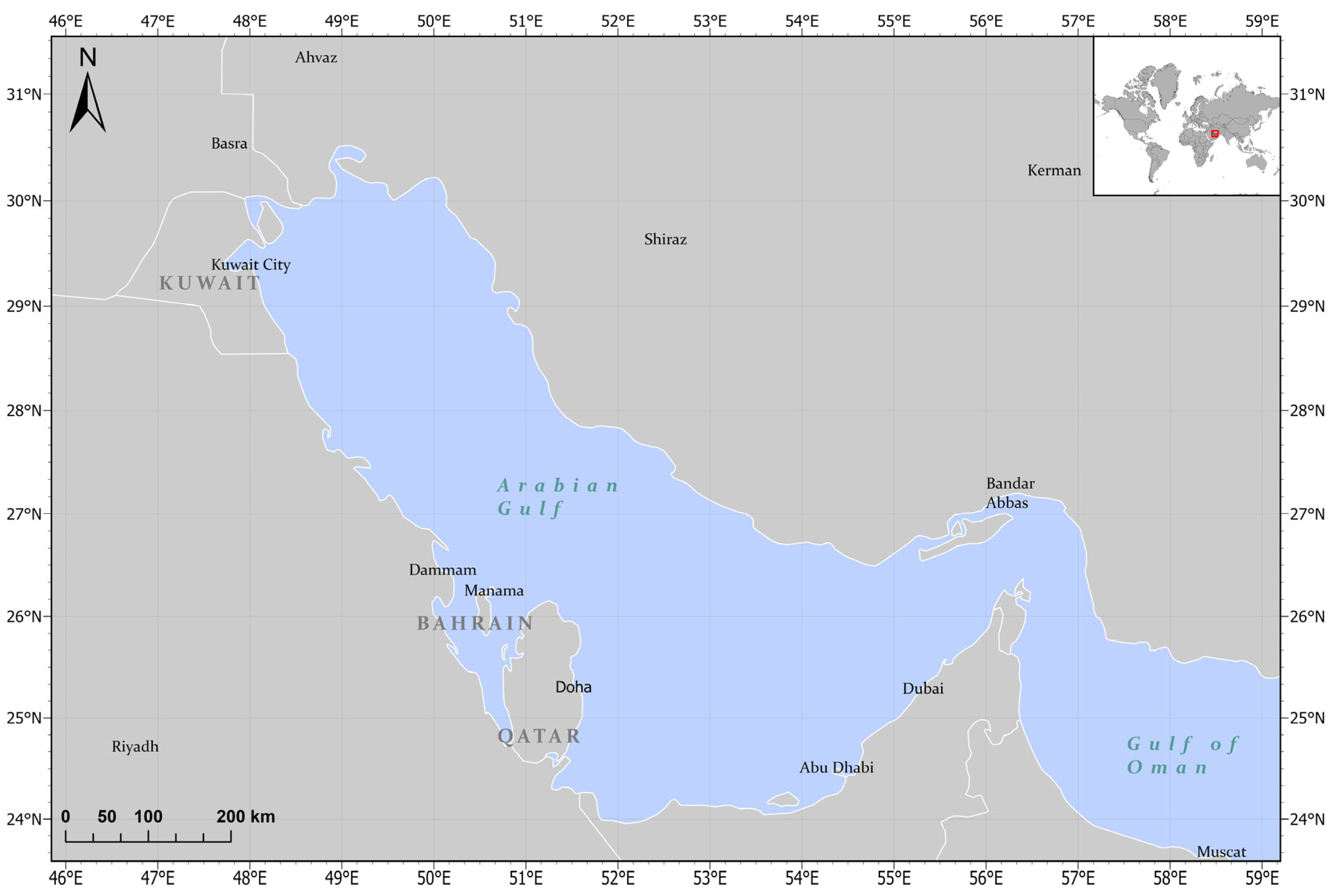


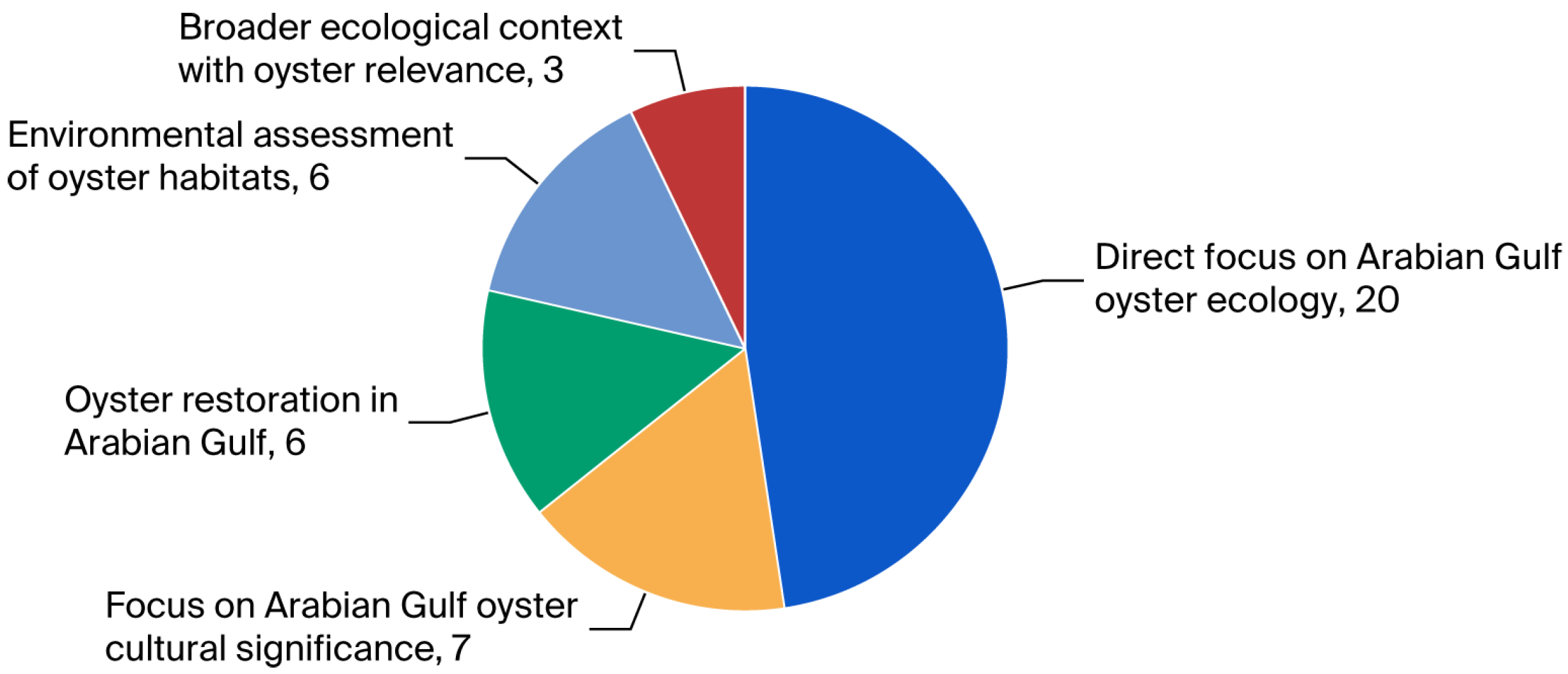
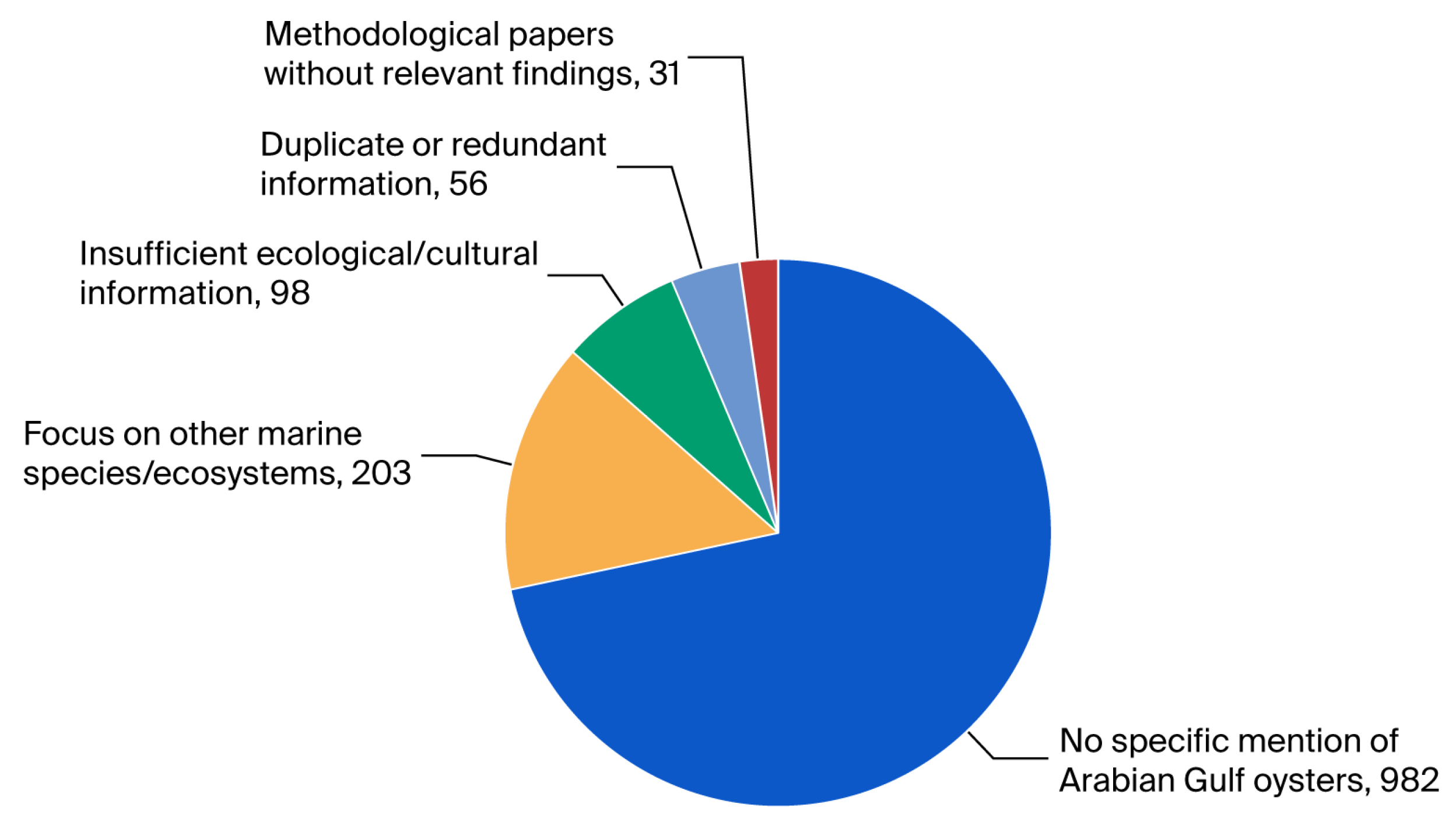
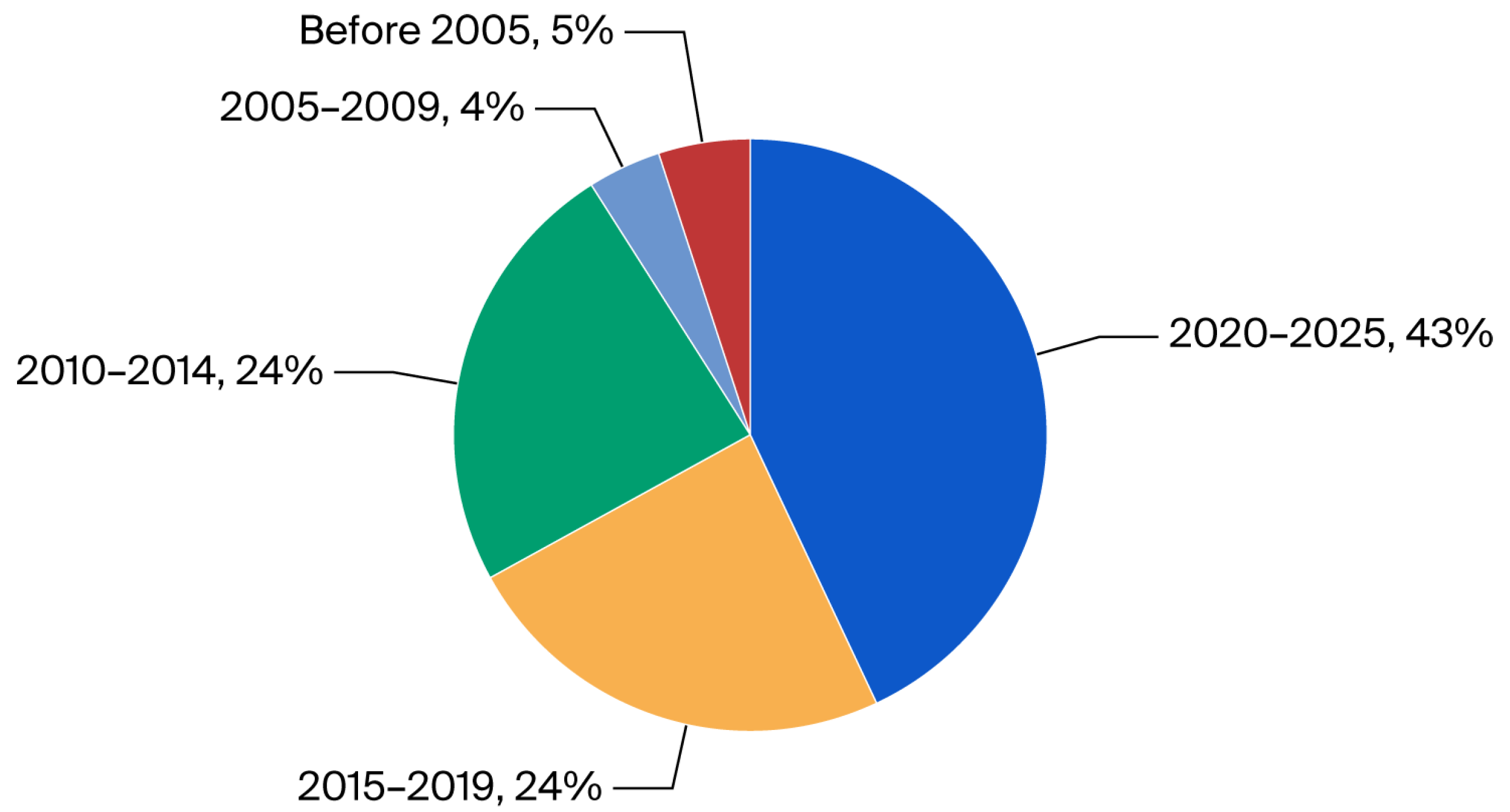
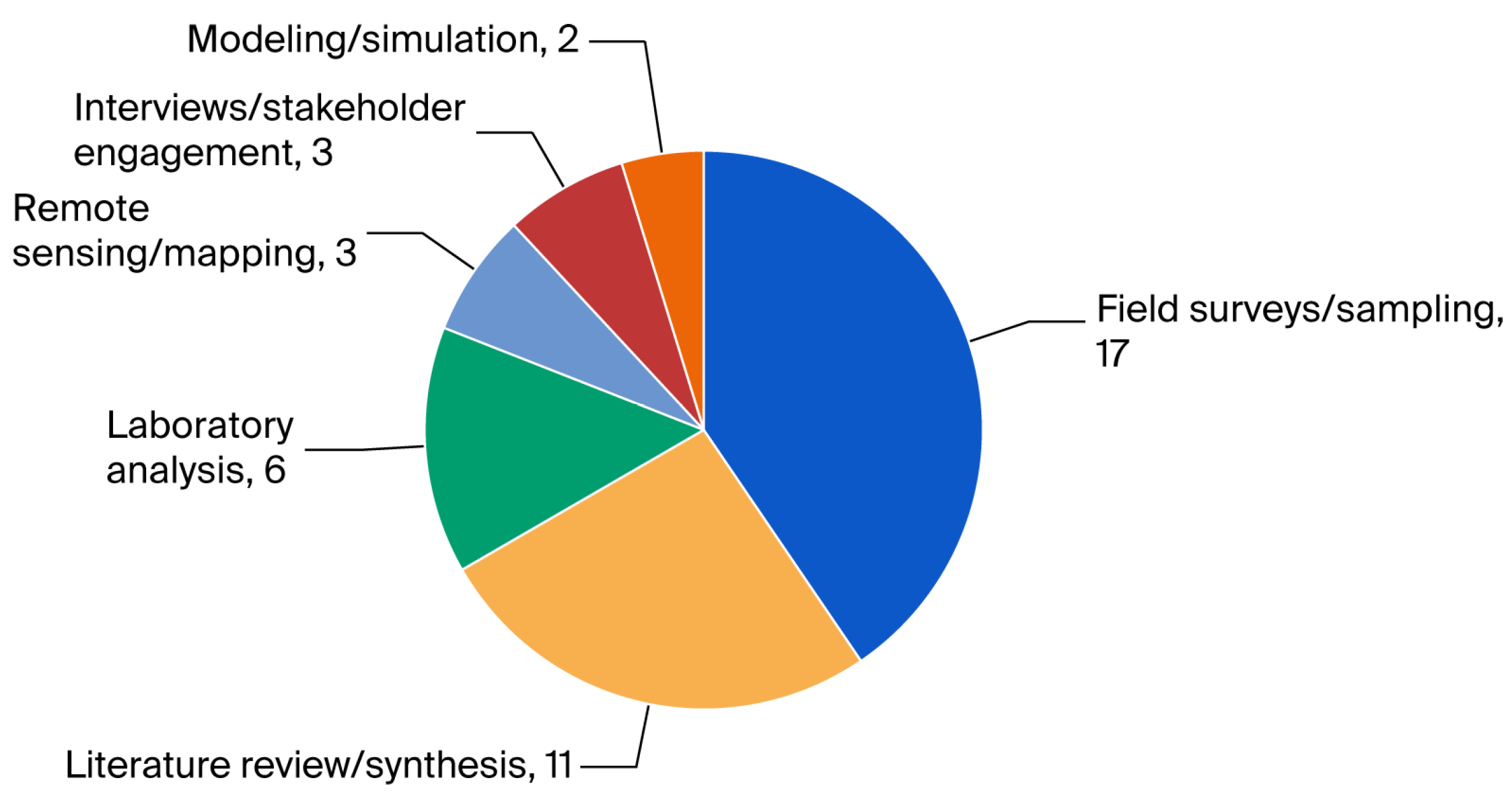
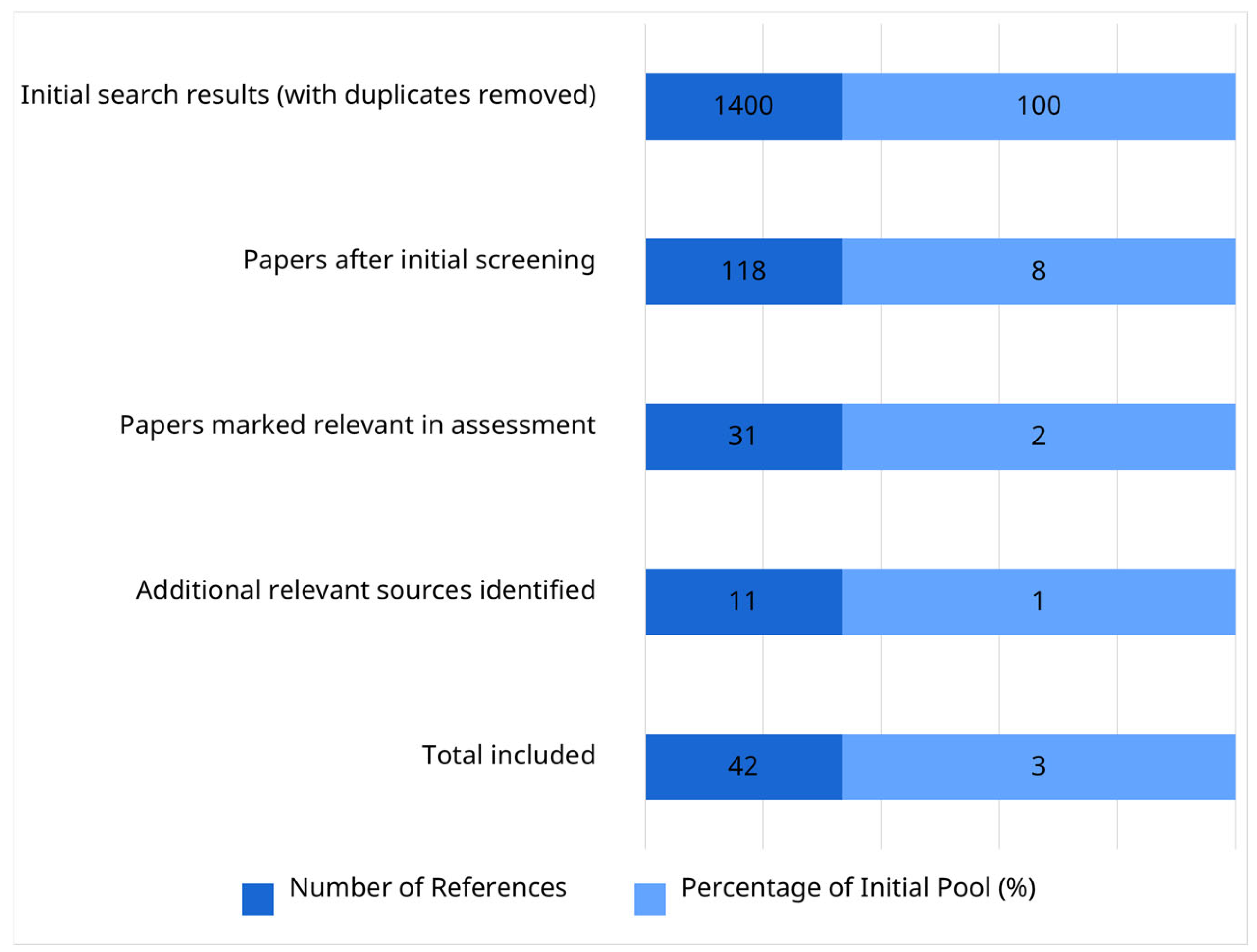
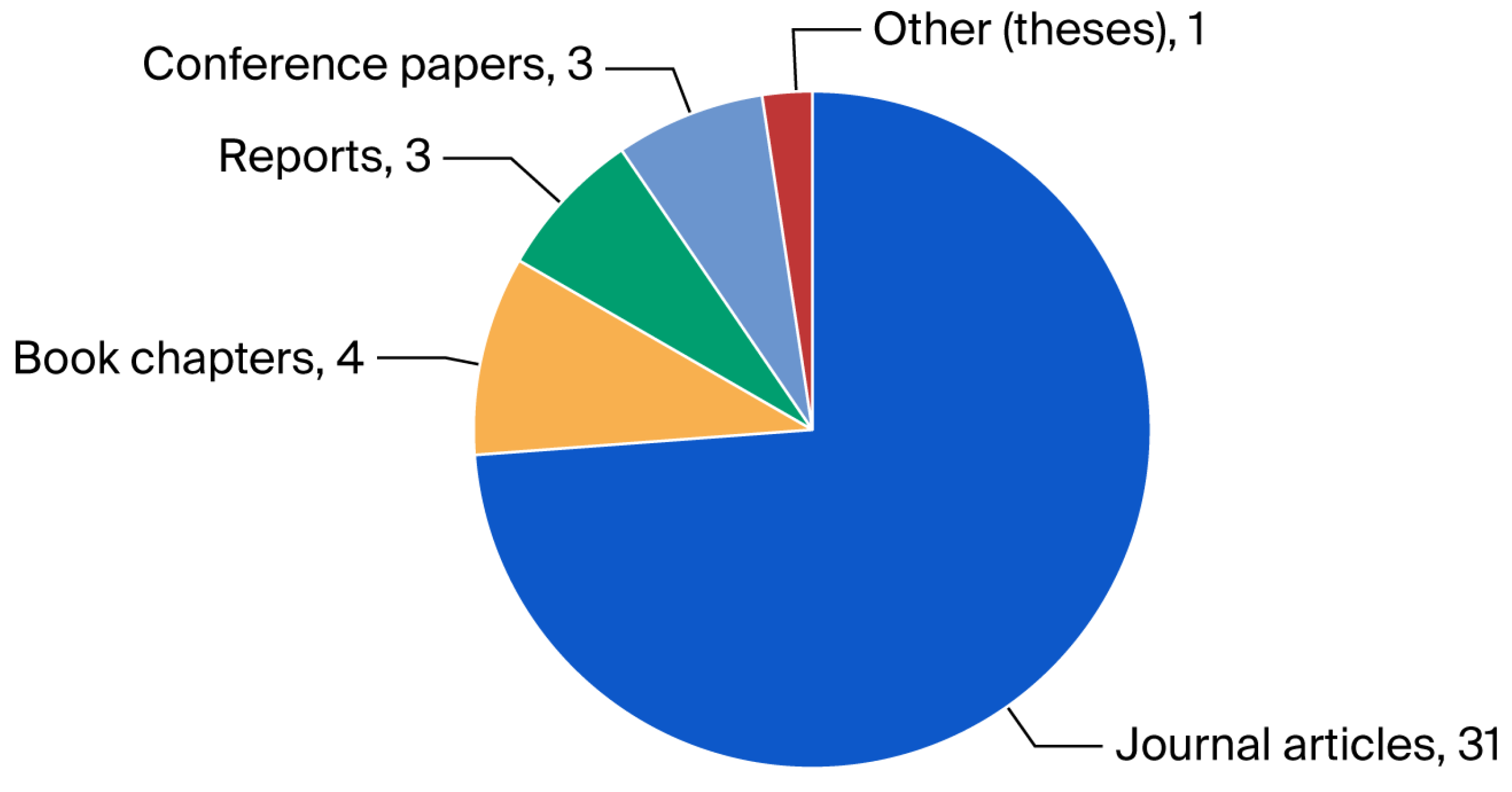

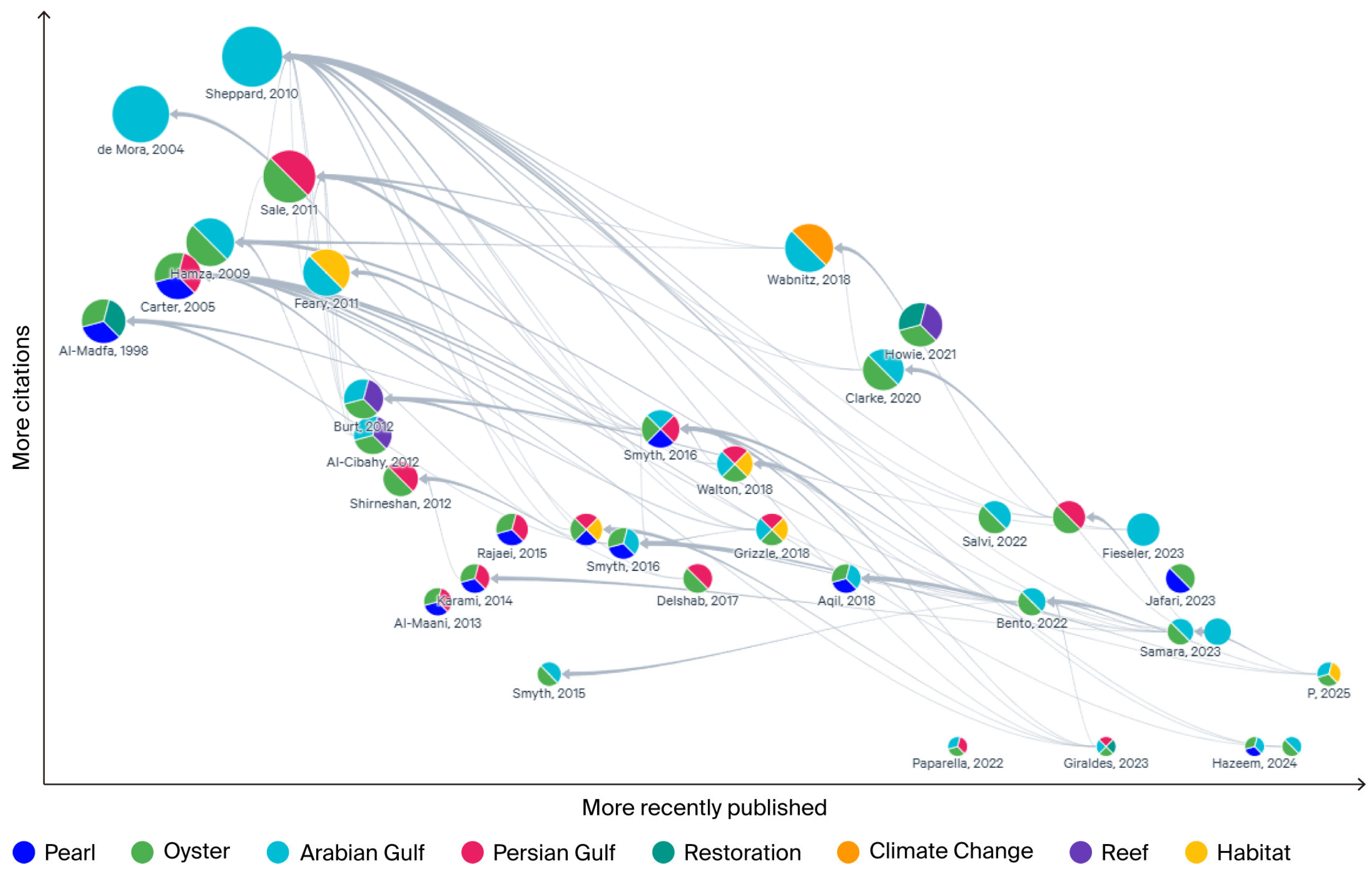
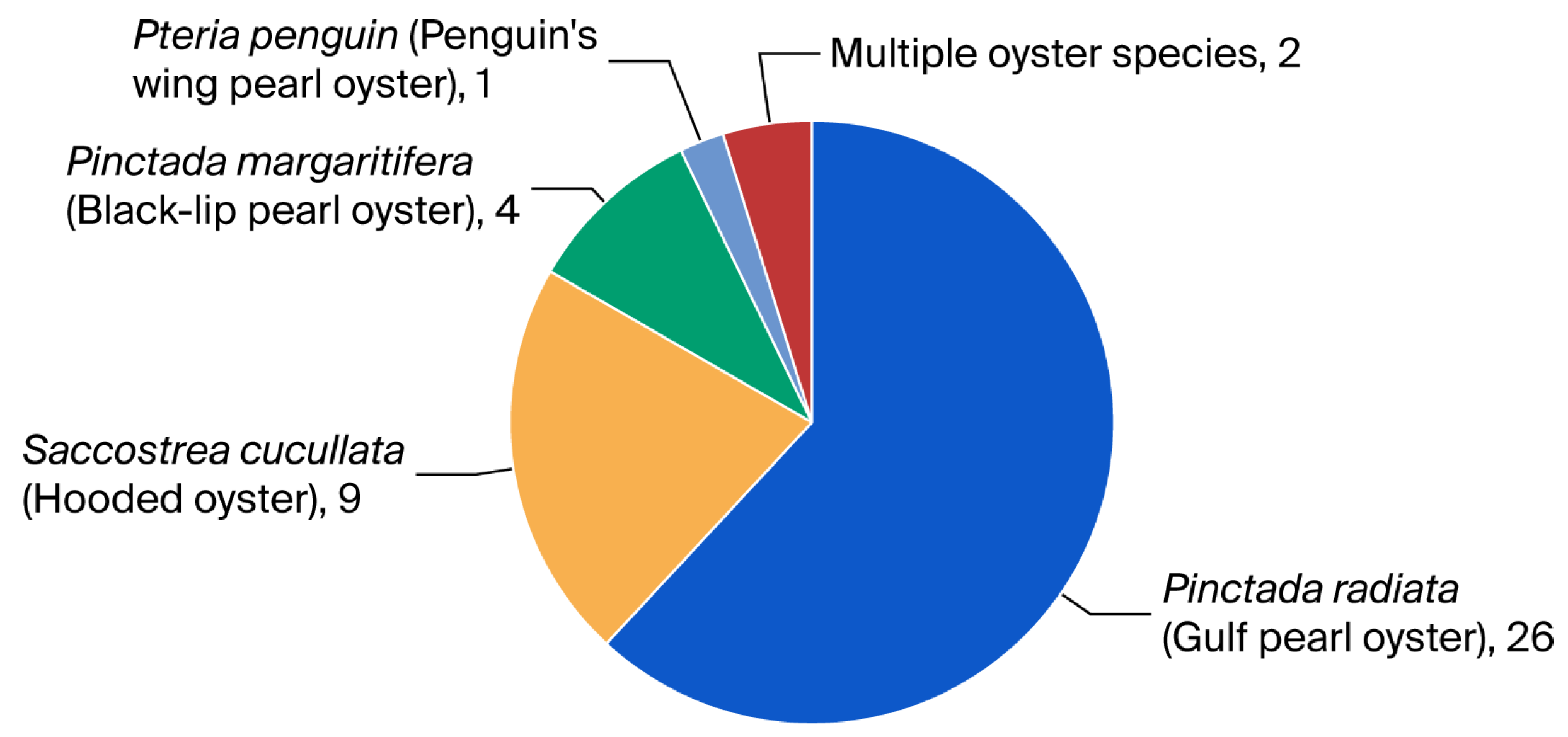
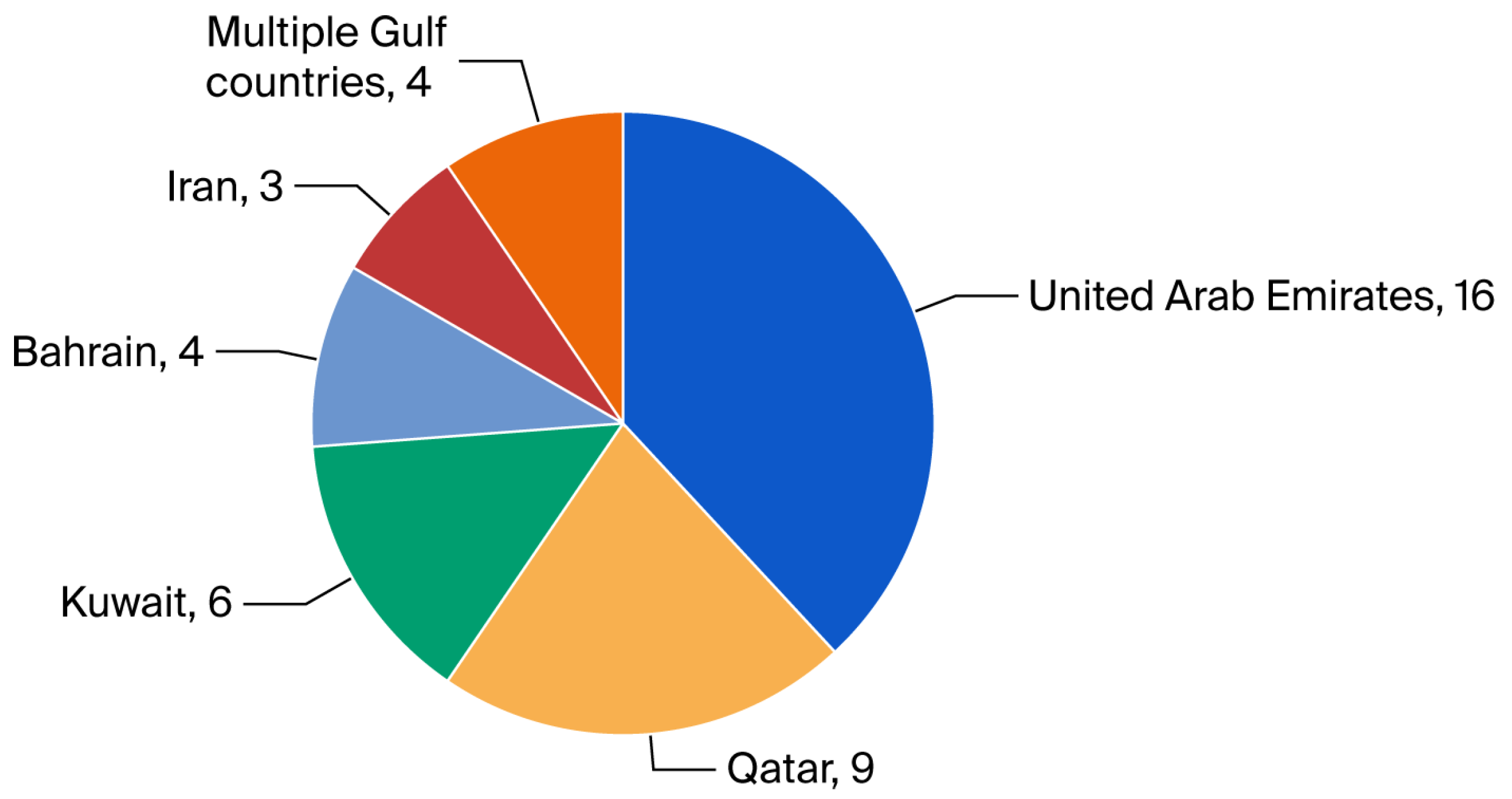
| Search Query | Number of Results | Number Included | Inclusion Rate (%) |
|---|---|---|---|
| Geographical distribution, species diversity, environmental impact, and conservation management of oyster beds in the Arabian Gulf | 420 | 13 | 3.1 |
| Ecological roles and restoration practices of oyster beds in the Arabian Gulf | 380 | 11 | 2.89 |
| Impacts of environmental change and management strategies on oyster reef ecosystems in the Arabian Gulf | 310 | 8 | 2.58 |
| Ecological implications and management strategies for enhancing species diversity and conservation of oyster beds in the Gulf | 290 | 10 | 3.45 |
| Recent oyster restoration projects Arabian Gulf UAE Qatar Kuwait | 180 | 6 | 3.33 |
| Environmental assessment oyster beds northern Arabian Gulf | 150 | 4 | 2.67 |
| Oyster restoration projects Qatar Arabian Gulf | 120 | 3 | 2.5 |
| Total (with duplicates removed) | 1400 | 42 | 3 |
Disclaimer/Publisher’s Note: The statements, opinions and data contained in all publications are solely those of the individual author(s) and contributor(s) and not of MDPI and/or the editor(s). MDPI and/or the editor(s) disclaim responsibility for any injury to people or property resulting from any ideas, methods, instructions or products referred to in the content. |
© 2025 by the authors. Licensee MDPI, Basel, Switzerland. This article is an open access article distributed under the terms and conditions of the Creative Commons Attribution (CC BY) license (https://creativecommons.org/licenses/by/4.0/).
Share and Cite
Alkhuzaei, M.; Aljenaid, S.; Mohamed, G. Systematic Review: The Ecology and Cultural Significance of Oysters in the Arabian Gulf. Diversity 2025, 17, 565. https://doi.org/10.3390/d17080565
Alkhuzaei M, Aljenaid S, Mohamed G. Systematic Review: The Ecology and Cultural Significance of Oysters in the Arabian Gulf. Diversity. 2025; 17(8):565. https://doi.org/10.3390/d17080565
Chicago/Turabian StyleAlkhuzaei, Manaf, Sabah Aljenaid, and Ghadeer Mohamed. 2025. "Systematic Review: The Ecology and Cultural Significance of Oysters in the Arabian Gulf" Diversity 17, no. 8: 565. https://doi.org/10.3390/d17080565
APA StyleAlkhuzaei, M., Aljenaid, S., & Mohamed, G. (2025). Systematic Review: The Ecology and Cultural Significance of Oysters in the Arabian Gulf. Diversity, 17(8), 565. https://doi.org/10.3390/d17080565






